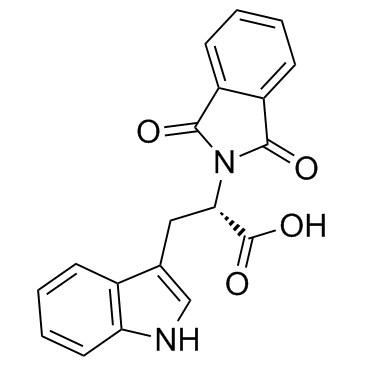RG108

RG108 structure
|
Common Name | RG108 | ||
|---|---|---|---|---|
| CAS Number | 48208-26-0 | Molecular Weight | 334.326 | |
| Density | 1.5±0.1 g/cm3 | Boiling Point | 606.0±50.0 °C at 760 mmHg | |
| Molecular Formula | C19H14N2O4 | Melting Point | 192-194℃ | |
| MSDS | USA | Flash Point | 320.3±30.1 °C | |
Use of RG108RG108 is a non-nucleoside inhibitor of DNA methyltransferase with an IC50 of 115 nM. |
| Name | RG 108 |
|---|---|
| Synonym | More Synonyms |
| Description | RG108 is a non-nucleoside inhibitor of DNA methyltransferase with an IC50 of 115 nM. |
|---|---|
| Related Catalog | |
| Target |
CpG methylase M.SssI:115 nM (IC50) |
| In Vitro | RG108 effectively blocks DNA methyltransferases in vitro and does not cause covalent enzyme trapping in human cell lines. Incubation of cells with low micromolar concentrations of RG108 results in significant demethylation of genomic DNA without any detectable toxicity. Intriguingly, RG108 causes demethylation and reactivation of tumor suppressor genes, but it does not affect the methylation of centromeric satellite sequences[1]. In another study, the synthesis and in vitro analysis of a biotinylated RG108 conjugate is investigated to evaluate the interactions with DNA methyltransferase enzymes[2]. In a recent study, it is shown RG108 can significantly reduce the DNA methyltransferases activity in SM derived iPS cells as compared to the native SMs[3]. |
| Kinase Assay | The substrate DNA for the in vitro methylation assay is a 798 bp fragment (−423/+375 relative to the initiation codon) from the promoter region of the human p16Ink4a gene. The methylation reaction contains 350 to 400 ng substrate DNA and 4 units of M.SssI methylase (0.5 μM) in a final volume of 50 μL. Inhibitors are added to final concentrations of 10, 100, 200, and 500 μM, respectively. Reactions are done at 37°C for 2 hours. After completion, the reaction is inactivated at 65°C for 15 minutes and the DNA is purified using PCR Purification kit. Three hundred nanograms of purified DNA is digested for 3 hours at 60°C with 30 units of BstUI and analyzed on 2% Tris-borate EDTA agarose gels. |
| References |
| Density | 1.5±0.1 g/cm3 |
|---|---|
| Boiling Point | 606.0±50.0 °C at 760 mmHg |
| Melting Point | 192-194℃ |
| Molecular Formula | C19H14N2O4 |
| Molecular Weight | 334.326 |
| Flash Point | 320.3±30.1 °C |
| Exact Mass | 334.095367 |
| PSA | 90.47000 |
| LogP | 3.33 |
| Appearance of Characters | yellow |
| Vapour Pressure | 0.0±1.8 mmHg at 25°C |
| Index of Refraction | 1.741 |
| Storage condition | Store at RT |
| Water Solubility | DMSO: >10mg/mL |
| RIDADR | NONH for all modes of transport |
|---|
|
Inhibition of DNA methyltransferase as a novel therapeutic strategy to overcome acquired resistance to dual PI3K/mTOR inhibitors.
Oncotarget 6(7) , 5134-46, (2015) Dual PI3K/mTOR(phosphatidylinositol 3-kinase/mammalian target of rapamycin) inhibitors are being evaluated clinically for the treatment of tumors with a hyperactivated PI3K/mTOR pathway. However, unex... |
|
|
c-ETS transcription factors play an essential role in the licensing of human MCM4 origin of replication.
Biochim. Biophys. Acta 1849 , 1319-28, (2015) In metazoans, DNA replication is a highly regulated and ordered process that occurs during the S phase of cell cycle. It begins with the licensing of origins of replication usually found in close prox... |
|
|
DNA methyltransferase DNMT3A associates with viral proteins and impacts HSV-1 infection.
Proteomics 15 , 1968-82, (2015) Viral infections can alter the cellular epigenetic landscape, through modulation of either DNA methylation profiles or chromatin remodeling enzymes and histone modifications. These changes can act to ... |
| DNA Methyltransferase Inhibitor |
| N-phthalimide l-tryptophane |
| 1H-Indole-3-propanoic acid, α-(1,3-dihydro-1,3-dioxo-2H-isoindol-2-yl)-, (αS)- |
| N-Phthalyl-L-tryptophan |
| (2S)-2-(1,3-Dioxo-1,3-dihydro-2H-isoindol-2-yl)-3-(1H-indol-3-yl)propanoic acid |
| N-Phth-Trp-OH |
| RG108 |